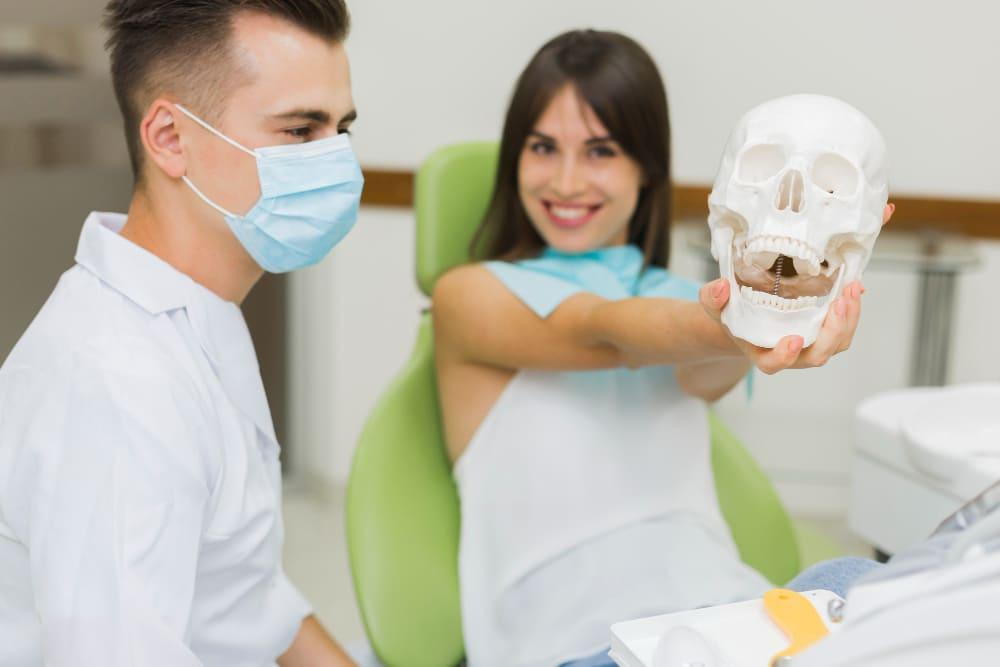
Sometimes, our teeth and gums need a little extra help to stay strong and look their best. That's where dental bone grafting comes in. It might sound a bit scary, but it's actually a common and helpful procedure that dentists use to give your smile the support it needs.
Let's talk about what dental bone grafting is, when you might need it, and how it can help keep your smile bright and healthy.
What is Dental Bone Grafting?
Imagine you're building a house. You need a strong foundation to support the walls and roof, right? Well, your teeth are like the house, and your jawbone is the foundation. Sometimes, that foundation can get weak or damaged. Dental bone grafting is a way to make that foundation strong again.
In simple terms, bone grafting is when a dentist adds new bone material to your jaw. This new bone helps support your teeth and gums. It's like adding extra cement to the foundation of a house to make it stronger.
The bone used in grafting can come from different places:
- Your own body: Sometimes, dentists take a small piece of bone from another part of your body, like your hip or the back of your jaw.
- Donated bone: This is bone that comes from a tissue bank, kind of like how people donate blood.
- Animal bone: Some grafts use specially treated bone from animals, usually cows.
- Synthetic materials: Scientists have created artificial materials that can help your body grow new bone.
When is Bone Grafting Recommended?
Now that we know what bone grafting is, let's talk about when you might need it. Here are some common reasons:
- Getting Ready for Dental Implants: If you're missing a tooth and want to get a dental implant (a fake tooth that's put into your jawbone), you need strong bone to hold it. If your jawbone is too thin or soft, your dentist might recommend bone grafting to make it strong enough for the implant.
- Saving Teeth from Gum Disease: Gum disease can damage the bone around your teeth. Bone grafting can help rebuild this bone and save teeth that might otherwise fall out.
- Fixing Bone Loss After Tooth Removal: When a tooth is taken out, the bone that held it can start to shrink. Bone grafting can help keep the shape of your jaw and make it easier to put in a replacement tooth later.
- Improving the Look of Your Smile: Sometimes, bone loss can change the shape of your face. Bone grafting can help restore the natural shape of your jaw and improve how your smile looks.
- Supporting Dentures: If you wear dentures, having enough bone in your jaw helps them fit better. Bone grafting can create a better foundation for your dentures.
The Bone Grafting Procedure: What to Expect
If your dentist recommends bone grafting, here's what you can expect:
- Examination: First, your dentist will carefully check your mouth and take X-rays to see exactly where you need the bone graft.
- Preparation: On the day of the procedure, the dentist will make sure you're comfortable. They'll use local anesthesia to numb the area, so you won't feel pain.
- The Graft: The dentist will make a small cut in your gum to reach the bone. Then, they'll add the new bone material and cover it with a special membrane.
- Closing Up: After the graft is in place, the dentist will close the cut with stitches.
- Healing: Over the next few months, your body will grow new bone around the graft material. This process is called "osseointegration," which means the new bone becomes part of your jaw.
After the Procedure: Taking Care of Your Graft
After you get a bone graft, it's important to take good care of it. Here are some tips:
- Follow your dentist's instructions carefully.
- Take any medicines your dentist gives you to prevent infection and manage pain.
- Eat soft foods for a few days and avoid chewing on the side of your mouth where you had the graft.
- Don't smoke, as it can slow down healing.
- Be gentle when brushing your teeth, especially near the graft site.
- Attend all your follow-up appointments so your dentist can check how you're healing.
Your dentist is the best person to talk to about bone grafting in detail and answer any questions you might have. Don't be afraid to ask questions – understanding your dental care is an important part of keeping your smile bright and healthy!
